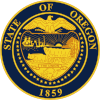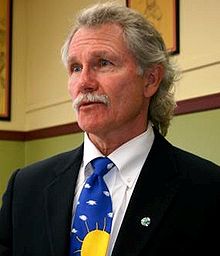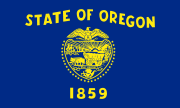- Governor of Oregon
-
Governor of Oregon 
Style The Honorable Residence Mahonia Hall Term length Four years, limited to 2 consecutive terms with no limit on total number of terms Inaugural holder John Whiteaker Formation February 14, 1859 Salary $93,600 Website governor.oregon.gov The Governor of Oregon is the top executive of the government of the U.S. state of Oregon. The title of governor was also applied to the office of Oregon's chief executive during the provisional and U.S. territorial governments.
The current governor of Oregon is John Kitzhaber, a Democrat, who also served two terms from 1995 to 2003. The Governor's current salary was set by the 2001 Oregon Legislature at $93,600 annually, seventh lowest in the nation.[1][2]
Contents
Constitutional descriptions
Article V of the Oregon State Constitution sets up the legal framework of the Oregon Executive Branch.[3]
Eligibility
Article V, Section 1 states that the governor must be a U.S. citizen, at least 30 years old, and a resident of Oregon for at least three years before the candidate's election. Section 2 extends ineligibility to the following:
“ No member of Congress, or person holding any office under the United States, or under this State, or under any other power, shall fill the Office of Governor, except as may be otherwise provided in this Constitution.[3] ” Elections and terms of office
Article V, sections 4-7, outline the formal gubernatorial election procedures such as publishing the winner, ties, disputed elections, and terms of office.
Governors are elected by popular ballot and serve terms of four years, limited to two consecutive terms in office, with no limit on the number of total terms.
The formal process of certification of results of a gubernatorial election ends when the Secretary of State delivers the results to the Speaker of the Oregon House of Representatives. The Speaker then will publish the results to a joint session of the Oregon Legislative Assembly.
Where an election results in a tie, a joint session of the next legislative session will vote on the two candidates, and declare the winner governor. Legally contested elections are also decided by the full legislature in whichever manner other laws may prescribe.
Line of succession
The gubernatorial line of succession was modified in 1920 and 1946, only to be repealed and replaced by a new section in 1972.[4] The current list is designated as Article V, Section 8a. It defines who may become or act as the Governor of Oregon upon the incapacity, death, resignation, or removal from office of a sitting governor. The acting governor will serve out the remainder of the outgoing governor's term until the next election. Unlike many states, Oregon does not have a Lieutenant Governor (though in 2007, legislation was proposed to establish such an office.)[5] The current chain is:
# Position Current office holder Party 1 Secretary of State Kate Brown Democratic 2 State Treasurer Ted Wheeler Democratic 3 President of the Senate Peter Courtney Democratic 4 Speaker of the House Dave Hunt Democratic State military forces
The governor is the commander-in-chief of Oregon Military Department. Power is granted to the governor to mobilize and deploy state military forces.
Pardons
The power to grant pardons and reprieves and to commute sentences is granted to the governor, with limitations placed upon cases of treason. Additionally, the governor can remit fines and forfeitures. Any use of these powers, however, must be reported to the legislature.
In treason cases, the governor may only grant reprieves. The final matter of pardons, commuting of sentencing, or further reprieves is referred to the legislature in these cases.
Legislative
The governor has the power to veto legislation, which can be overridden by a two-thirds majority in both houses of the legislature, and can veto particular items from an appropriations or emergency bill while leaving others intact (see line item veto).
If needed, the governor may convene a special session of the legislature by proclamation and is empowered to call for special elections to fill vacant seats. Between the vacancy and special election, the governor is able to appoint a replacement.
Annually, the governor addresses the legislature in his State of the State address. In this speech the governor outlines the current conditions of the state, and makes recommendations to the assembly as to what the government's priorities ought to be.
Appointments
If the legislature is out of session, the governor may appoint replacements to fill state offices until elections are held or the legislature reconvenes (see recess appointment).
Official residence
Mahonia Hall in Salem is the official governor's mansion.[6] The house was built in 1924 for hops grower Thomas A. Livesley. It was named Mahonia Hall after citizens raised funds in 1988 to purchase it as Oregon's first official governors' mansion.[7] It is located at 533 Lincoln Street in Salem.
Before the purchase of Mahonia Hall, whatever house the governor rented became the "Governor's mansion".[8] Governors Atiyeh and McCall lived in the 1929 Stiff-Jarman House, an English cottage-style (also characterized as Arts and Crafts style)[9] residence currently located in the North Capitol Mall Historic Redevelopment area.[10][11] After the end of Atiyeh's term, the Stiff-Jarman House became the headquarters of the Oregon Department of Environmental Quality.[9] Today the building houses rented offices.[10]
Provisional Government (1843–1848)
Meetings at Champoeg led up to the first constitution of the Oregon Country, and a petition for U.S. territorial status. The resulting acts also created this body as a provisional government for the region. The first executives of this government were a three-person, elected committee known as the Executive Committee. In 1845, elections for a chief executive were held. The first person in Oregon to hold the title of governor was George Abernethy, a prominent businessman.[12]
Gubernatorial data
Note: These facts apply only to persons who have held the Governorship under Oregon Statehood.
Age and longevity
- Excluding Governors who died in office, Julius L. Meier had the shortest post-governorship. He died 2½ years after the expiration of his term.
- Including situations where an acting governor took over, Frank W. Benson, had the shortest post-governorship, living only 9 months after transferring his office in 1910 due to illness.[citation needed]
- Sworn in at the age of 33, Jay Bowerman was the youngest person to act as Governor.[citation needed]
- Sworn in at the age of 34, George L. Woods was the youngest person elected Governor.[citation needed]
- Sworn in at the age of 71, General Charles H. Martin was the oldest Governor.[citation needed]
- Three governors were born in other countries:
- Four governors died in office:[citation needed]
- James Withycombe in 1919[14]
- Isaac L. Patterson in 1929
- Earl Snell in 1947
- Paul L. Patterson in 1956
- Walter M. Pierce had the longest life-span of any governor, 92 years.[citation needed]
- Earl Snell had the shortest life-span of any governor, 52 years.[citation needed]
Transition events
Three Governors have resigned:[citation needed]
- La Fayette Grover in 1877 to become a United States Senator
- George Chamberlain in 1909 to become a United States Senator
- Douglas McKay in 1952 to become United States Secretary of the Interior
Eight Governors took office without being elected to the Governor's seat, having assumed the office by means of the Gubernatorial Line of Succession:[citation needed]
- One of them did not run to succeed himself, and was never elected Governor:
- Secretary of State Stephen F. Chadwick in 1877
- One transferred powers to an Acting Governor:
- Secretary of State Frank W. Benson in 1909
- One Acting Governor, who unsuccessfully attempted a second term:
- President of the Senate Jay Bowerman in 1910
- Three of them attempted to seek a second term, but did not prevail:
- Secretary of State Ben W. Olcott in 1919
- President of the Senate A. W. Norblad in 1929
- President of the Senate Elmo Smith in 1956
- The other two later ran for Governor, and were elected to succeed themselves as Governor:
- Speaker of the House John H. Hall in 1947
- President of the Senate Paul L. Patterson in 1952
References
- ^ Wong, Peter (July 9, 2006). "4-year freeze sets some salaries askew". Statesman-Journal (Salem, Oregon: Gannett Co.): pp. A8.
- ^ Knapp, Andrew (2007-05-15). "Govs' salaries range from $1 to $206,500". Stateline.org. http://www.stateline.org/live/details/story?contentId=207914. Retrieved 2011-01-12.
- ^ a b "Constitution of Oregon: Article V, Executive Department". Oregon Blue Book. Oregon State Archives. http://bluebook.state.or.us/state/constitution/constitution05.htm. Retrieved 2007-04-21.
- ^ "Temporary governor eliminated: Measure modifies line of succession". The Bend Bulletin. http://news.google.com/newspapers?nid=1243&dat=19721025&id=0pcSAAAAIBAJ&sjid=gvcDAAAAIBAJ&pg=1387,2212415.
- ^ "Proposes amendment to Oregon Constitution to create elective office of Lieutenant Governor.". Oregon State Legislature. http://www.leg.state.or.us/07reg/measures/hjr1.dir/hjr0003.intro.html. Retrieved 2007-04-21.
- ^ "Architecture". State of Oregon Highway - Geo-Environmental Section. http://www.oregon.gov/ODOT/HWY/GEOENVIRONMENTAL/architecture1.shtml. Retrieved 2007-04-21.
- ^ "Livesley House/Mahonia Hall, Salem, Oregon 1992". Oregon Historic Photograph Collections, Salem Public Library. Retrieved January 11, 2011.
- ^ Oregon Historic Photograph Collections
- ^ a b Oregon Historic Photograph Collections
- ^ a b Oregon Department of Administrative Services, New State Owned Office Space Available
- ^ North Mall Office Building, Department of Administrative Services, Sustainable State Facilities Guidelines Policy, Pilot Project Report
- ^ "George Abernethy". Oregon State Library. http://www.osl.state.or.us/home/lib/governors/ga.htm. Retrieved 2007-04-21.
- ^ "Notable Oregonians: Oswald West - Governor". Oregon Blue Book. http://bluebook.state.or.us/notable/notwest.htm. Retrieved 2007-04-21.
- ^ a b "James Withycombe". Oregon State Library. http://www.osl.state.or.us/home/lib/governors/jwith.htm. Retrieved 2007-04-21.
- ^ "Albin Walter Norblad". Oregon State Library. http://www.osl.state.or.us/home/lib/governors/awn.htm. Retrieved 2007-04-21.
See also
Categories:- Governors of Oregon
Wikimedia Foundation. 2010.



